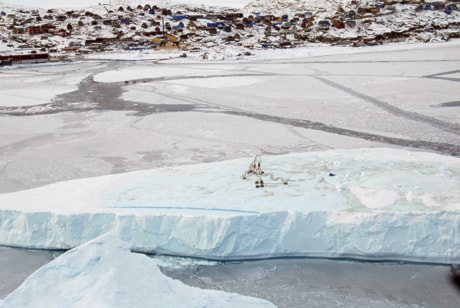When Dutch sculptor Ap Verheggen put statues of dogsleds on an iceberg drifting down the Davis Strait, he thought it would be a good way to make a point about climate change.
He was right. Maybe a little too right.
Instead of a long, slow drift to Newfoundland that would normally take several years, Verheggen’s iceberg has collapsed after just a couple of months. His stylized dogsleds are now sitting under 500 metres of water off the coast of Greenland.
“Everybody, even the Inuit, they thought a mountain, an iceberg that size, would survive for maybe two, three, four years,” says Verheggen. “It overruled all our expectations.”
Last March, Verheggen travelled to the small Greenlandic coastal community of Uummannaq, not far from the famous section of coast where massive chunks of the Greenland ice cap break into the Davis Strait. His plan was to place two sculptures of stylized dogsleds on icebergs and let them drift south until the icebergs melted.
The message was that Nature is in control and the world better start adapting to climate change.
Normally, an iceberg the size that Verheggen chose would take a couple years to drift down to Newfoundland. But this year, Arctic sea water is so warm that icebergs calving off the Greenland ice sheet are cracking and crumbling instead of melting.
“The temperatures in the water are so warm that the icebergs explode,” Verheggen said. “When you are lying in your bed, the whole night you hear icebergs that are exploding.”
Data from the Earth System Science Center at The University of Alabama backs him up. Figures released Monday say a new average-high temperature record for the Arctic was set in May for the third time in the last four months.
And that’s what did in the dogsled iceberg. The berg disappeared last Thursday, shortly after Verheggen managed to collect some meltwater from it.
“That’s the only thing that remains of our complete art project — two small bottles of water.”
The sculptures aren’t likely to be recovered. Verheggen said they were deliberately made of iron, a mineral that is a useful nutrient for phytoplankton.
Verheggen hasn’t given up. He wants to try again, this time from a Canadian iceberg.
He says the sled’s rapid disappearance simply adds to his point.
“The impact that’s happening now is way more than we could believe.
“That’s what we wanted to tell people with this art project — ‘Guys, look how rapidly it’s going.’ But the facts overruled it and there’s way more impact than we could believe.”
